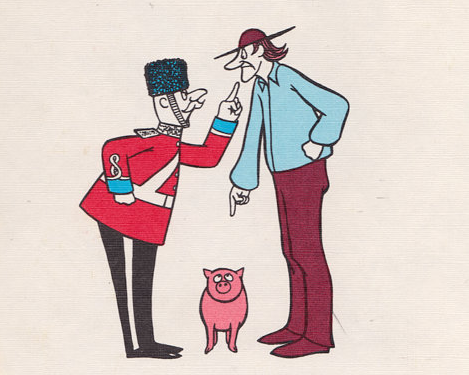If sometime in the near future you stood up in a crowd of people and confidently declared that everything was just hunky dory with the United States and England after the War of 1812 (which, by the way, is a conflict that makes for a terrible license plate) you’d look like an idiot. Because you’d be wrong. So, so wrong.
Enter: the Pig War of 1859.
Yes, a war named after the pig. The even-toed ungulate. Swine. The filthy animal that, while it’s often referred to as social and highly-intelligent, sleeps and roots in their own feces.
Here’s what it was all about, according to Wikipedia:
The Pig War was a confrontation in 1859 between the United States and the British Empire over the boundary between the US and the British Empire. The territory in dispute was the San Juan Islands, which lie between Vancouver Island and the North American mainland. The Pig War, so called because it was triggered by the shooting of a pig, is also called the Pig Episode, the Pig and Potato War, the San Juan Boundary Dispute or the Northwestern Boundary Dispute. With no shots exchanged and no human casualties, this dispute was a bloodless conflict.
Oh, and about that “pig”:
On June 15, 1859, exactly thirteen years after the adoption of the Oregon Treaty, the ambiguity led to direct conflict. Lyman Cutlar, an American farmer who had moved onto the island claiming rights to live there under the Donation Land Claim Act, found a large black pig rooting in his garden. He had found the pig eating his tubers. This was not the first occurrence. Cutlar was so upset that he took aim and shot the pig, killing it. It turned out that the pig was owned by an Irishman, Charles Griffin, who was employed by the Hudson’s Bay Company to run the sheep ranch. He also owned several pigs that he allowed to roam freely. The two had lived in peace until this incident. Cutlar offered $10 to Griffin to compensate for the pig, but Griffin was unsatisfied with this offer and demanded $100. Following this reply, Cutlar believed he should not have to pay for the pig because the pig had been trespassing on his land. (A possibly apocryphal story claims Cutlar said to Griffin, “It was eating my potatoes.” Griffin replied, “It is up to you to keep your potatoes out of my pig.” When British authorities threatened to arrest Cutlar, American settlers called for military protection.
Military protection arrived, in the form of three British warships. The U.S. dispatched about 66 infantry soldiers to keep the redcoats from landing on the islands. George Pickett, who keep in mind didn’t even have Twitter back then, received national recognition and flack for saying that he’d “make a Bunker Hill” out of the situation. More time went on and the conflict continued to escalate, with each side collecting more and more military assets to pit against one another.
Cooler head(s) finally prevailed when the Brits ordered one of their admirals, Robert Baynes, to engage with the Americans and ignite a battle — and Baynes refused.
He put it this way (which sums it up nicely): “Two great nations in a war over a squabble about a pig?” Stupid.
Okay, so he didn’t say “stupid”, but he inferred it.
While insults were volleyed between both sides after Baynes’ famous declaration/decision, the news about the potentially flammable “quabble” ultimately got back to Washington, which left the President and other officials flabbergasted, but committed to dousing it as soon as possible.
They sent officials to negotiate with the British, and soon diffused the situation entirely … 12 years later.




































